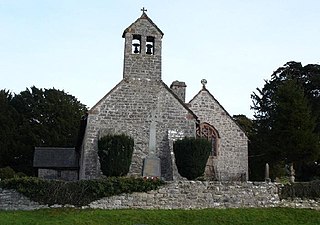Related Research Articles

Cefn Druids Association Football Club is an inactive association football team based in the village of Cefn Mawr, Wrexham. The club played in the Cymru North after being relegated from the Cymru Premier in 2021–22 but withdrew ahead of the 2023-24 season.

Until 1974, Montgomeryshire was an administrative county in mid Wales, later classed as one of the thirteen historic counties of Wales. It was named after its county town, Montgomery, which in turn was named after one of William the Conqueror's main counsellors, Roger de Montgomerie, who was the 1st Earl of Shrewsbury.

Chirk is a town and community in Wrexham County Borough, Wales, 10 miles south of Wrexham, between it and Oswestry. At the 2011 census, it had a population of 4,468. Historically in the traditional county of Denbighshire, and later Clwyd, it has been part of Wrexham County Borough since a local government reorganisation in 1996. The border with the English county of Shropshire is immediately south of the town, on the other side of the River Ceiriog.
Davies is a patronymic surname of Welsh origin. There are two main theories concerning its beginnings, neither of which has been definitively proved. The first theory states that it may be a corruption of "Dyfed", the name of a medieval Welsh kingdom located in what is now Carmarthenshire; however, the origin of the kingdom's name is itself disputed, with the traditional belief being that it was founded by the powerful Irish Déisi dynasty in the third century, or otherwise that it derives from the name of the Demetae people. "Dyfed" as a surname and the related first name "Dafydd" appear from the 12th century, with the latter generally translated into English as "David". The second theory contends that the surname may derive directly from the Hebrew name "David", which is also the name of Wales' patron saint.

Ruabon is a village and community in Wrexham County Borough, Wales. The name comes from Rhiw Fabon, rhiw being the Welsh word for "slope" or "hillside" and Fabon being a mutation from St Mabon, the original church name, of earlier, Celtic origin. An older English spelling, Rhuabon, can sometimes be seen.
Llywelyn, Llewelyn or Llewellyn is a name of Welsh language origins. See Llywelyn (name) for the name's etymology, history and other details.

Samuel Llewelyn Kenrick was a Welsh solicitor who became the founder of the Football Association of Wales and organised the first Welsh international football match against Scotland in 1876. As such he became the "father of Welsh football".
Wynn Hall is a 17th-century house in the old hamlet of Bodylltyn in Ruabon, Wrexham, Wales standing at the junction of the Penycae Road and Plas Bennion Road. It was built in about 1649 by William Wynn and is a Grade II* listed building.

Llanelidan is a small village and community in the county of Denbighshire in north-east Wales. The community also includes the hamlet of Rhyd-y-Meudwy.
This article is about the particular significance of the year 1847 to Wales and its people.
Morgan is a surname of Welsh origin.
This article is about the particular significance of the year 1795 to Wales and its people.
William Kenrick may refer to:
Ruabon Druids F.C. were a football club based in the village of Ruabon near Wrexham, Wales. The club was founded in October 1872 as 'Ruabon Rovers F.C.' by David Thomson and his brother, George, of Ruabon. In 1874 Ruabon Rovers F.C. became Plasmadoc F.C. before changing their name to Druids F.C. in 1876.
The Dictionary of Welsh Biography (DWB) is a biographical dictionary of Welsh people who have made a significant contribution to Welsh life over seventeen centuries. It was first published in 1959, and is now maintained as a free online resource.
George Frederick Thomson was a Welsh amateur footballer who helped found the Druids club and played for Wales in their first two international matches.
David Thomson was an England-born Welsh amateur footballer who helped found the Druids club and played for Wales in their first international match. He has been described as "one of the pioneers of Welsh football".

Nantclwyd Hall is a 17th-century Grade II* listed mansion near the village of Llanelidan, Denbighshire, Wales, built by the Parry family, and rebuilt by Eubule Thelwall and his wife Mary Parry, the heiress of the estate.

Eubule Thelwall was a landowner and solicitor who held legal offices in North Wales and Cheshire, and the third son of John Thelwall of Bathafarn Park, Ruthin. In 1646 he served in the siege of Denbigh Castle and was sent by William Salesbury, the castle's governor, to Charles I to seek his permission to surrender. Thelwall married Marry Parry, the heiress of Nantclwyd estate in 1653 and instigated a complete rebuild of the building and of a second, smaller building in the nearby town of Ruthin: Nantclwyd y Dre, which is Wales's oldest dated timbered town house.
References
- ↑ "Kenrick family, of Woore, Shropshire, Cerniogau and Nantclwyd, Denbighshire". Llyfrgell Genelaethol Cymru / National Library of Wales. Retrieved February 17, 2024.
- ↑ "Kenrick History, Family Crest & Coats of Arms". House of Names. Retrieved February 17, 2024.
- ↑ Lower, Mark Anthony (1860). Patronymica Britannica, A Dictionary of Family Names of the United Kingdom. London: John Russel Smith.
- 1 2 3 "Last name: Kenrick". SurnameDB. Name Origin Research 1980 - 2024. Retrieved February 17, 2024.
- ↑ "KENRICK family of Wynn Hall, Denbighshire, and Bron Clydwr, Merionethshire". Dictionary of Welsh Biography. Name Origin Research 1980 - 2024. Retrieved February 17, 2024.
- ↑ Filby, P. William; Meyer, Mary K. (1985). Passenger and Immigration Lists Index. Detroit, Mich.: Gale. ISBN 0-8103-1795-8.